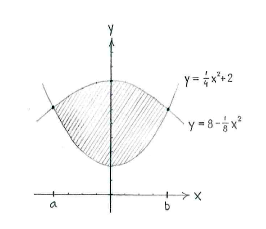Lösung 2.1:4c
Aus Online Mathematik Brückenkurs 2
K |
K (Robot: Automated text replacement (-{{Displayed math +{{Abgesetzte Formel)) |
||
| Zeile 7: | Zeile 7: | ||
The region is bounded above by the parabola <math>y=8-x^2/8</math> and below by the parabola <math>y=x^2/4+2</math>. If we can determine the ''x''-coordinates, <math>x=a</math> and <math>x=b</math>, for the points of intersection between the curves, the area we are looking for will be given by | The region is bounded above by the parabola <math>y=8-x^2/8</math> and below by the parabola <math>y=x^2/4+2</math>. If we can determine the ''x''-coordinates, <math>x=a</math> and <math>x=b</math>, for the points of intersection between the curves, the area we are looking for will be given by | ||
| - | {{ | + | {{Abgesetzte Formel||<math>\text{Area} = \int\limits_{a}^{b} \bigl(\bigl(8-\tfrac{1}{8}x^2\bigr) - \bigl(\tfrac{1}{4}x^2+2\bigr)\bigr)\,dx\,\textrm{.}</math>}} |
The integrand is the ''y''-value for the upper parabola minus the corresponding ''y''-value for the lower parabola. | The integrand is the ''y''-value for the upper parabola minus the corresponding ''y''-value for the lower parabola. | ||
| Zeile 13: | Zeile 13: | ||
At the points where the curves intersect each other, the ''x''- and ''y''-coordinates are equal, which gives the equation system, | At the points where the curves intersect each other, the ''x''- and ''y''-coordinates are equal, which gives the equation system, | ||
| - | {{ | + | {{Abgesetzte Formel||<math>\left\{\begin{align} |
y &= 8-\tfrac{1}{8}x^2\,,\\[5pt] | y &= 8-\tfrac{1}{8}x^2\,,\\[5pt] | ||
y &= \tfrac{1}{4}x^2+2\,\textrm{.} | y &= \tfrac{1}{4}x^2+2\,\textrm{.} | ||
| Zeile 20: | Zeile 20: | ||
If we eliminate ''y'' from this system, we get the following equation for ''x'', | If we eliminate ''y'' from this system, we get the following equation for ''x'', | ||
| - | {{ | + | {{Abgesetzte Formel||<math>8-\tfrac{1}{8}x^2 = \tfrac{1}{4}x^2+2\,\textrm{.}</math>}} |
If we move the <math>x^2</math>-terms onto one side and the constants onto the other, we obtain | If we move the <math>x^2</math>-terms onto one side and the constants onto the other, we obtain | ||
| - | {{ | + | {{Abgesetzte Formel||<math>\tfrac{1}{4}x^2 + \tfrac{1}{8}x^2 = 8-2\,,</math>}} |
i.e. | i.e. | ||
| - | {{ | + | {{Abgesetzte Formel||<math>\begin{align} |
\bigl(\tfrac{1}{4}+\tfrac{1}{8}\bigr)x^2 &= 6\,,\\[5pt] | \bigl(\tfrac{1}{4}+\tfrac{1}{8}\bigr)x^2 &= 6\,,\\[5pt] | ||
\tfrac{3}{8}x^2 &= 6\,,\\[5pt] | \tfrac{3}{8}x^2 &= 6\,,\\[5pt] | ||
| Zeile 38: | Zeile 38: | ||
The area of the area between the curves is given by | The area of the area between the curves is given by | ||
| - | {{ | + | {{Abgesetzte Formel||<math>\begin{align} |
\text{Area} &= \int\limits_{-4}^{4} \Bigl(\Bigl(8-\frac{1}{8}x^2\Bigr)-\Bigl( \frac{1}{4}x^2+2\Bigr) \Bigr)\,dx\\[5pt] | \text{Area} &= \int\limits_{-4}^{4} \Bigl(\Bigl(8-\frac{1}{8}x^2\Bigr)-\Bigl( \frac{1}{4}x^2+2\Bigr) \Bigr)\,dx\\[5pt] | ||
&= \int\limits_{-4}^{4}\Bigl(8-\frac{1}{8}x^2-\frac{1}{4}x^2-2\Bigr)\,dx\\[5pt] | &= \int\limits_{-4}^{4}\Bigl(8-\frac{1}{8}x^2-\frac{1}{4}x^2-2\Bigr)\,dx\\[5pt] | ||
Version vom 12:59, 10. Mär. 2009
First, we need a picture of what the region looks like.
Both curves, \displaystyle y=x^2/4+2 and \displaystyle y=8-x^2/8, are parabolas, the first with a minimum value \displaystyle y=2 when \displaystyle x=0, and the second with a maximum value of \displaystyle y=8 when \displaystyle x=0. Roughly speaking, the curves have the appearance shown in the figure below, where the shaded region whose area we are trying to find lies between the curves.
The region is bounded above by the parabola \displaystyle y=8-x^2/8 and below by the parabola \displaystyle y=x^2/4+2. If we can determine the x-coordinates, \displaystyle x=a and \displaystyle x=b, for the points of intersection between the curves, the area we are looking for will be given by
| \displaystyle \text{Area} = \int\limits_{a}^{b} \bigl(\bigl(8-\tfrac{1}{8}x^2\bigr) - \bigl(\tfrac{1}{4}x^2+2\bigr)\bigr)\,dx\,\textrm{.} |
The integrand is the y-value for the upper parabola minus the corresponding y-value for the lower parabola.
At the points where the curves intersect each other, the x- and y-coordinates are equal, which gives the equation system,
| \displaystyle \left\{\begin{align}
y &= 8-\tfrac{1}{8}x^2\,,\\[5pt] y &= \tfrac{1}{4}x^2+2\,\textrm{.} \end{align}\right. |
If we eliminate y from this system, we get the following equation for x,
| \displaystyle 8-\tfrac{1}{8}x^2 = \tfrac{1}{4}x^2+2\,\textrm{.} |
If we move the \displaystyle x^2-terms onto one side and the constants onto the other, we obtain
| \displaystyle \tfrac{1}{4}x^2 + \tfrac{1}{8}x^2 = 8-2\,, |
i.e.
| \displaystyle \begin{align}
\bigl(\tfrac{1}{4}+\tfrac{1}{8}\bigr)x^2 &= 6\,,\\[5pt] \tfrac{3}{8}x^2 &= 6\,,\\[5pt] x^2 &= 16\,\textrm{.} \end{align} |
The x-coordinates of the points of intersection are therefore equal to \displaystyle x=-4 and \displaystyle x=4\,.
The area of the area between the curves is given by
| \displaystyle \begin{align}
\text{Area} &= \int\limits_{-4}^{4} \Bigl(\Bigl(8-\frac{1}{8}x^2\Bigr)-\Bigl( \frac{1}{4}x^2+2\Bigr) \Bigr)\,dx\\[5pt] &= \int\limits_{-4}^{4}\Bigl(8-\frac{1}{8}x^2-\frac{1}{4}x^2-2\Bigr)\,dx\\[5pt] &= \int\limits_{-4}^{4}\Bigl(6-\Bigl(\frac{1}{8}+\frac{1}{4}\Bigr)x^2\Bigr)\,dx\\[5pt] &= \int\limits_{-4}^{4}\Bigl(6-\frac{3}{8}x^2\Bigr)\,dx\\[5pt] &= \Bigl[\ 6x-\frac{3}{8}\frac{x^3}{3}\ \Bigr]_{-4}^{4}\\[5pt] &= \Bigl[\ 6x-\frac{x^3}{8}\ \Bigr]_{-4}^{4}\\[5pt] &= 6\cdot 4 - \frac{4^3}{8} - \Bigl(6\cdot (-4) - \frac{(-4)^3}{8}\Bigr)\\[5pt] &= 24-8+24-8\\[5pt] &= 32\,\textrm{.} \end{align} |

